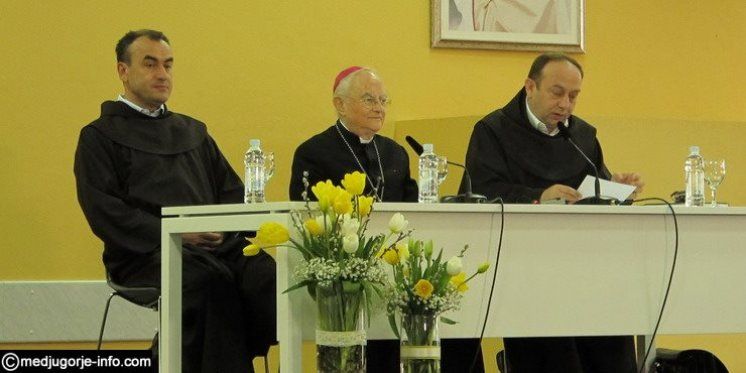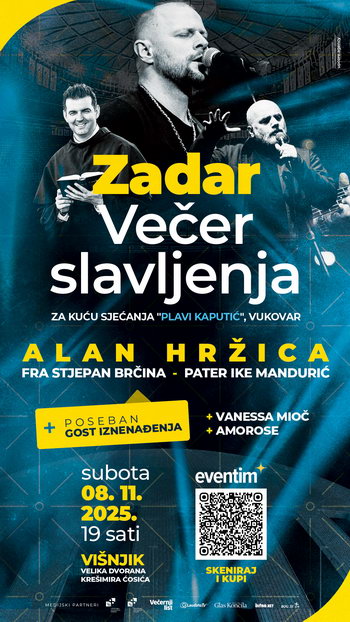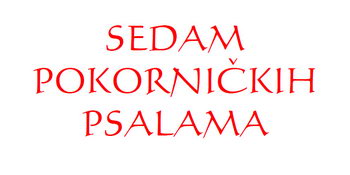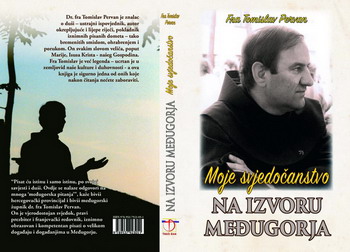Even though there were about fifty journalists registered, the interest for this event was much greater. The conference was translated into the Croatian, English, Italian, German and French languages, and those were the official languages spoken during the conference, while a translation was also given in the Polish, Spanish and Slovakian languages.
Dr. Fr Miljenko Šteko, the Provincial of the Herzegovinian Franciscan Province of the Assumption of the Blessed Virgin Mary, spoke at the beginning of the conference and said:
- Respected media representatives, as you are aware, the Press Office of the Holy See, released a statement on February, 11, 2017, that the Holy Father, Pope Francis appointed a Special Envoy of the Holy See for Medjugorje, his Excellency Archbishop Mons. Dr. Henryk Hoser, the Bishop of the Archdiocese of Warsaw – Praga in Poland. The purpose of his mission is 'to acquire a profound understanding of the pastoral situation of this reality, and above all about the needs of the faithful who come here on pilgrimage, and on the basis of that understanding, to suggest possible pastoral initiatives for the future. This mission shall, therefore, have an exclusively pastoral character. It is expected that Mons. Hoser, who will continue to exercise the office of Bishop of Warsaw – Praga, completes his mission by the end of this summer.' Now, this was the statement of the Holy See. Accordingly, the Archbishop arrived to Medjugorje as the Special Envoy. As the Apostolic Nuncio’s Office in Bosnia and Herzegovina announced, the Archbishop wanted to meet today with you, respected media representatives. So, I now ask the Archbishop to address you and then he will answer some of your questions.
This is what Mons. Hoser said about the impressions he gained while in Medjugorje in the past week:
- Ladies and gentlemen, good afternoon to you all. At the very beginning, I ought to give you some explanations and I owe you a few apologies too. The scope of my mission was defined by the Holy See. As we have heard, it is about determining the pastoral situation of the pilgrims in Medjugorje. This is my first visit to Medjugorje, I came here without knowing the exact situation here, but I knew this was an international pilgrimage destination. I will speak in French, as this language has been the official language for diplomacy for many years, even up to today. Certainly, you all expect to hear my impressions and my conclusions. First of all, I would like to emphasise a very important fact, that Medjugorje once was not known in the world at all. It was a small place, lost in the hills, which is what its name actually means. Today, Medjugorje is known all over the world, and it should be pointed out that pilgrims come from eighty different countries. When it comes to the importance of this place of pilgrimage, it could be compared to others too. For instance, two and a half million pilgrims come to Medjugorje each year, while six million go to Lourdes. Nevertheless, Lourdes exists for 150 years, while Medjugorje is hardly 36 years old. This is a time to make a first balance, a first estimate that could be highly important for the future development of this place.
How come so many pilgrims come here? On one hand, they have surely heard about the Medjugorje apparitions that began in 1981. On the other hand, those who come here, discover something extraordinary. The first aspect is the environment, the atmosphere of peace and of reconciliation. It is also an atmosphere of inner peace, peace of the heart. They also discover a huge range of profound spirituality. They re-discover or discover for the first time in their lives the meaning of the sacred reality. In Medjugorje, they can have an experience with sacred time and sacred space. Sacred means it is something withheld in a special way in relation to God.
Usually we hear that Medjugorje is a place of Marian devotion, and that is the truth, however, if we enter into the depth of it, we can see that devotion in Medjugorje is very Christ-centred, as the centre of devotion is the celebration of the Eucharist, the transmitting of the Word of God, Adoration of the Blessed Sacrament, when man discovers that the Blessed Sacrament is the real presence of Jesus in His divinity and in His human nature. Some discover here the prayer of the Rosary, which is meditative prayer on the mysteries of our faith. Finally, as they pray the Way of the Cross, they enter into the Easter mystery, meaning the Passion, Death and Resurrection of the Christ. I shall conclude this overview, with the strongest point on the sacrament of forgiveness, personal and personalised confession.
Medjugorje is a very fertile land from a religious perspective. In these years we can count 610 religious and priesthood vocations born in Medjugorje. Most of them come from Italy, the United States and Germany. When we are aware of the crisis of vocations, particularly in the old Christian countries, and in Western Europe, it is clear that there is something new here, something remarkable.
If we calculate the number of the ministered Holy Communions, as this is the only way to establish the number of pilgrims, of course including the margin of error, there have been 37 million Holy Communions ministered in the period from 1986-2016. However, the number of pilgrims is even bigger, as not all of them receive Holy Communion.
When it comes to the estimate of the situation in Medjugorje, there are three different areas to differentiate.
The first area is the parish that exists for a long time, which serves the parishioners who are here, who live here and whose number has increased in the past ten years by a thousand of those who came to live here, perhaps even more than that. This parish, that has its own history, built a cross on a hill in Medjugorje in the thirties of the past century, and has accepted today’s phenomenon of Medjugorje. Part of the history of this parish is also special, the personal history of those whom we call the visionaries.
The second area: pilgrims. As I already said, up to 2 500 000 of them per year. This number tends to grow, too. Surely, this is a huge challenge for the priests who are here. This phenomenon has caused development of the existing infrastructure that needs to respond to the needs of pilgrims, and part of that is this Hall, the Adoration chapel, the open area for the celebration of Holy Mass outdoors. Those were some of the elements added according to the needs of pilgrims who were coming here. On the other hand, we can see how this place is developing. There are more and more hotels, restaurants, shops and this already reminds me of little Lourdes. It is not known that Lourdes is second in France, after Paris, according to the number of hotels in it. Perhaps this is the future of Medjugorje in relation to Sarajevo. So, the number of the inhabitants is increasing, as well as the capacity of accommodation of pilgrims.
However, we can see the third area, too. There are the communities that came here, associations, social and charity activities, we think there are around thirty of them. Some of them received their inspiration from Medjugorje, their roots are from here. There are also those who arrived from the other countries, they were founded somewhere else, but they came here so they would live this atmosphere, this phenomenon of Medjugorje.
There are some originally created works here; in a particular way I am mentioning a work created by Franciscan fathers, the charitable institution, the Mother’s village. It is worth visiting this place if you are interested in that, as it is about life in its various stages, specially life in a difficulty: orphans, young people with troubles, addicts on drugs, alcohol and other additions, those who are disabled. This is an expression of active love tightly related to the Christian faith. There is another work called the House of Peace, also established by the Franciscan fathers, it is a house for a closed type of spiritual retreats in silence. More than 1200 groups were in this House up to this day, with more than 42000 participants. This type of spiritual exercises, these seminars are transforming people from the inside.
There are also seminars – another pastoral invention of the parish of Medjugorje. The seminars are annual, they take place once a year. For the past 23 years there has been one open for all, for the past 21 years there is a seminar specifically for priests, it is for further formation of priests, for the past 17 years there have been seminars for married couples, and for the last 4 years, seminars for doctors and medical staff. Last year the first seminar for life took place, for the protection of human life. There is also a seminar for people with disabilities. So, all this shows an intensity of Christian life here in Medjugorje and this is a type of model that could be applied to other places.
What shrines have to offer in this world today is of such a kind, that Pope Francis has transferred the issue from the Congregation for the Clergy, to the Congregation for the New Evangelisation. People there receive what they cannot find at home. In many of our old Christian countries, individual confession no longer exists. In many countries there is no Adoration of the Blessed Sacrament, many countries do not know about the Way of the Cross, there is no prayer of the Rosary. In French Brittany, I was once told that the last time they prayed the Way of the Cross was thirty years ago. Surely, such dryness in the areas of the spiritual and the sacred is causing a crisis in faith in general.
People here come to the source; this is where they discern a thirst for the sacred, a thirst for God, a thirst for prayer which they discover to be an immediate contact with God. They feel, I would say the Divinity, thanks to the care of the Blessed Virgin Mary.
In Medjugorje, the emphasis is on Mary as Queen of Peace. One could say this is nothing new, as there are churches throughout the world consecrated to the Queen of Peace, but if we observe the world context of our lives today, we can see something that pope Francis refers to as the third world war in pieces. This means in fragments. Civil wars are the cruellest form, the one that destroys and hurts the most. You, who live here in the Balkans, have recently lived one such war. I lived in Rwanda during the genocide. Now you can see that Syria, in the Middle East, the country of the oldest Christian identity is being destroyed even with the use of chemical weapons. This is our landscape today. There are so many political conflicts in each country. So, in my opinion, it is important to pray to Our Lady of Peace. The specific role of Medjugorje is extremely important here.
You, my dear friends, should be the carriers of the joyful news. Say to the whole world that in Medjugorje we can find the light again. We need those special places of light in the world that is sinking into darkness. I would also like to say to you that you can register for a seminar here, whatever the theme, you might discover things that you cannot even imagine. Thank you!
The second part of the conference was an opportunity for press members to ask some questions and we bring some of them.
Danuta Liese, Poland: Is it possible for a priest from Poland to be in the service of pilgrims in this parish all the time? Not just occasionally, as a guest, but permanently?
- I think it is up to the Provincial priest to talk to the provinces in Poland so they would send a priest who would be here all the time, as it is case with other priests.
Sanja Pehar, Radio MIR Medjugorje: After the experiences you received in these days, where do you see Medjugorje in the new evangelisation that the Church is emphasising so much?
- I think that Medjugorje is already in the new evangelisation. The numbers I have given prove that. Also, there is increasing dynamics among the pilgrims, meaning that the needs will grow too.
Ivica Đuzel, Croatian Radio TV: I found information on Internet that you spoke to the visionaries last week, with people who had, we could say, that intimate encounter. What was their impression on you?
- It is correct that the contact with the visionaries is a part of my mission, but not in the sense of a deeper investigation, as it is up to Doctrinal Commission led by Cardinal Ruini. The visionaries were in Vatican and they spoke about their experiences there. I had chance to meet some of them here in a normal, very immediate contact. We should not forget they are no longer “boys and girls”, they are no longer children. Some of them are even grannies now. To respect their role, we should see that they are immersed in a normal, family life, in their professional life, they need to take care of their children and grandchildren, and their care makes them similar to all of us. Some of them are ill, some worry how to provide for a life, and so on. It is normal life, I would say. They – according to what they say – have had a privilege of interior apparitions. It is not my role to give my opinion on whether these apparitions are authentic or not. The Church has not yet made a statement about that.
Ivan Ugrin, Slobodna Dalmacija: Our Lady said in one message here that she came to continue the work she started in Fatima…
- You can read the history of recognised apparitions. I can mention, for instance, La Salette – half of the 17th century, Rue du Bac, Lourdes, Fatima, Banneux in Belgium – in the year when Hitler took the power, do not forget that, but also Guadalupe in the South America – colonial quest of the American Indians… All those apparitions have one element in common, the Blessed Virgin Mary’s invitation to conversion, to renounce sin, and each shows the challenges of every period. Finally, I would like to mention the apparitions in Kibeho. I lived in Rwanda for 21 years and I participated in the work of Commission of doctors for the apparitions that happened a year after Medjugorje. The Blessed Virgin Mary had already showed the spectrum of the genocide that took place 12 years afterwards. That was one warning. The message is similar to the message here in Medjugorje, it is invitation to conversion, to peace, and those apparitions were recognised by the Church. Those places are like sister towns, I would say, according to the historical context and nearness of the period when they took place. There were many doubts whether the visionaries were genuine or not, whether they were saying fairy tales or not, and so on. Some of them were, actually, rejected. Therefore, I would like to invite you to have patience, because as the issue is more complex, it takes more time to come to valid conclusions.
Paolo Brosio, Mediaset Mondadori: I saw your photograph on Apparition Hill next to the Statue of Our Lady and I was deeply moved by that. There are stories in Italy how Cardinal Ruini concluded the work of the commission after three and a half years and was able to verify that the apparitions in the first days and in the first months were genuine. How do you feel about those conclusions? Have you read the final reports of the Commission?
- Unfortunately, I did not read material of that Commission, as it was not released. Upon my return to the Vatican, I could have access to it, or at least talk to the Cardinal Ruini, but for the time being I cannot say anything. My mission is not only to talk to the people who are working here, who are responsible or not responsible for the situation here, but also to visit places of pilgrimages. That is why I climbed that, not so easy path to the statue of Our Lady, that everyone should climb simply because the statue of Our Lady is there. I met a group of pilgrims there, some of them were from Poland, and I spoke to them briefly about Marian devotion. The press had, of course, already stated that I took a group of pilgrims there, which is not the truth.
Darko Pavičić, Večernji list: When you talk about the apparitions in Medjugorje, you talk about the apparitions, not about the alleged apparitions. Do you believe that here, it is the case of the apparitions, and what was the topic of your meeting with Bishop of Mostar, Ratko Peric, who does not believe in the apparitions and who is denying them?
- It is clear that I sustain from giving my own judgment about this as I am not familiar with all of the details, I do not know the huge work done by Ruini’s Commission. If I speak about the apparitions, it is because that expression is used here. I do say that with quotation marks, but when I speak, quotation marks cannot be seen. I, as well as you, expect the final saying of the Commission, particularly of the Holy Father who will have his word on this.
Ivan Pavković, Al Jazeera: How does Pope feel about Medjugorje, about the apparitions and the fruits you spoke about?
- That is a very good question, but obviously, I do not know how the Pope feels about this. He did not say that to me. So, we are to wait, as the Pope is surely reflecting on all investigated materials and the job that was done in the process, but I think his judgment is going to be influenced by the fact that Medjugorje is such an important place in the perspective of the new evangelisation. I think this can be very important when the final decision is made. I do not speak about the Last Judgment, but about the final decision.
Ines Grbić, LaudatoTV: In the statement given prior to your coming here, you said you would have to perform your mission in completely different conditions and circumstances. I would like to know what kind of circumstances those are and what is the way that differs from your previous way of working? You said that these apparitions of Mary are significantly different than the previous ones. What is so specific and different here?
- Surely, madam, you noticed the specific element of the apparitions that are in a new form, I would say, something that was not known in the past in this dimension. Firstly, there is duration of what we refer to Medjugorje apparitions. This is something that lasts for 36 years now. Medjugorje visionaries, is as when the entrance antiphon says „sine fine dicentes“, even though we know from the lives of the saints that some of them had the apparitions all of their lives. The second specific element is the number of these apparitions. Some have calculated even 47 000 individual apparitions. Six visionaries have personal apparitions, and perhaps that number could be calculated after 36 years, I do not know. Furthermore, these apparitions are not tied to one place. In Lourdes, the Blessed Virgin Mary always appeared in the grotto. In Fatima, she appeared above the oak tree that grew there. Here, according to what the visionaries say, the apparitions take place where the person is, at home, while travelling, in the church, and so on. Those are the specific elements that make the final evaluation process more difficult.








